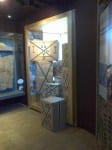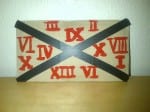The practitioner Mike Pearson, discuses the relationship between archaeology and performance. He states that for the performer it is a ‘series of physical, sensual and extra-daily experiences as alterations of perception and life strategies which may or may not be made explicit to the spectator, as sequences of tension, relaxation, and acceleration, changes of consequence and innovation.’. I feel like this quote resembles our attitude towards our performance, and how we are inviting the unprepared audience to our invasion of space and our concept of breaking the monotony of life.
During our performance we walk from our main side space in the contemporary gallery to its twin space on the other side, whilst the Collection itself is known for its quietness, stillness, and relaxing atmosphere, we immediately agreed on invading the rooms with us walking through with our boxes. Whilst we were robotic and cold to the spectators who did not know how to respond to us, our walking was peaceful and calm as we transferred the boxes between the spaces. To conclude our assessment concerning our twin performance spaces, we thought it was aesthetically pleasing to use the bringing down and revealing aspect to both sides.

In order to not deter the attention from the colourful balloons at the end, we dressed in black to create the allusion that we were not the centre attraction. The black tied in with the crosses on each box and the colourful paint we used contrasted well against the dark colours. Whilst the roman numerals played their own part, our sporadic and random place choices, for them allowed the audience to see our gradual breaking away from the conventional ‘routine’. We changed quite a bit over the last week, including the material used to write on the boxes. We went from scratchy black markers to colourful paints. Red and blue were the favourites, but due to there being 4 of us, we included other colours. These colours matched our balloon colours as an insignificant yet highly detailed link within our performance. The idea of the thin brush strokes and the effect it created on the cardboard immediately caught our attention and we stuck with the idea. We liked the contemporary feel and felt that our piece would coincide with the art surrounding our space.
We chose to not have our performance as a durational piece as we felt that if we performed over several hours, our walking through the gallery would become tiresome and not as intriguing. We also changed the idea of Tequila reading the poem, to all of us speaking. To prevent ourselves from messing up the words and ruining the effect of the piece, we recorded our poem with people coming in and speaking in a canon formation. This gave the impression of time never ending as when one person finished, others would still be speaking. We had it recorded so that it was playing in the background for dramatic effect. It was played 3 times, at the start, whilst we painted the roman numerals, and at the end, before we revealed our object. We felt that this created a cyclical feel to our performance and gave our piece depth. Doing our performance also within half an hour allowed our performance to appear blunt and something that shouldn’t be overlooked itself. Whilst the audience did not travel with us on all our transferring journeys, they all appeared at the end, wanting to see if we had a dramatic ending. In order to prolong the revealing of our balloons we replayed the voice-over poem in the back ground as we stood around the last box. This kept the audience anticipating our next move and whether we would even reveal our objects in the space. Once we had revealed our symbols of hope, we allowed the audience to view the space and reminisce over the importance and significance of our piece, especially in relation to the space.
Pearson, Mike (2010) Site-Specific Performance. London: Palgrave Macmillan.
